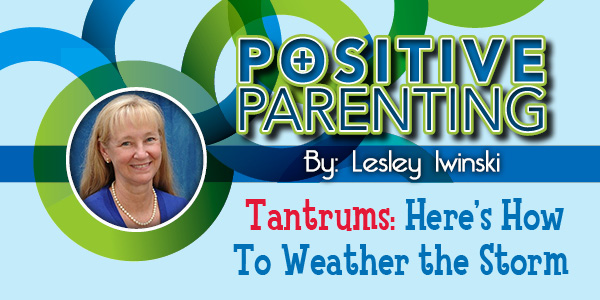Tantrums: Here’s How To Weather the Storm
It’s 9 p.m. on a May evening and a severe thunderstorm hits. The thunder and lightning begin, and it’s a doozy. You hear your little one crying and calling you. You go to her, and your calm and close presence reassures her.
“Ooo! That was a big one!” “It’s all right. You are safe. I’m here.”
The crying stops, the storm passes, and in your child’s brain there has been a little more development toward being able to calm and reassure herself when a storm comes in, even without you being there.
Someday, she will take storms in stride as part of life.
Big feelings like fear, sadness and pain are difficult for children to process and often elicit signs of distress.
These storms can often be weathered when you name the feeling and offer empathy to help them work through the emotion and decide what to do next.
Sometimes, the feelings are overwhelming and we see the manifestation of the inner storm in the form of a tantrum.
In a tantrum, a child is literally out of his own control. The alarm center in his brain, the amygdala, is sending him into fight, flight, freeze or faint mode.
His body is flooded with epinephrine and cortisol, and he may thrash around like he is fighting for his life.
He has no idea what is happening and doesn’t know that this terrifying experience won’t go on forever.
This often triggers a parent’s own fight or flight response. We feel that we must make this stop, that our child is doing this on purpose, and perhaps we just need to walk away and ignore it.
In the same way you provide calm and comfort to a child during a thunderstorm, you can help a child weather a tantrum.
Bring your calm to their storm. Here’s how:
- Take a few deep breaths and say to yourself: “I’ve got this.”
- Move toward your child with a gentle expression. If she reaches out to you, put an arm around her or hold her.
- If she tries to hit you, move out of the way, and don’t take it personally.
- Use as few words as possible, and speak quietly: “It’s all right. You are safe. I’m here.”
- If she is in danger of hurting herself, move things or remove her as gently as you can from the situation.
- Stay the course with compassion for the little person in front of you who is struggling very hard.
- When the storm passes, say, “You did some hard work. That was tough, wasn’t it?”
Every time you offer loving support to your child during a tantrum, just as you do during a thunderstorm, you are helping him develop the brain pathways that will enable him to calm himself when upset.
This is good news! Someday, he will take his emotions in stride as part of life, and use the information those feelings provide to take care of himself.
Dr. Lesley Iwinski is the mother of three grown children, a family physician and owner of Growing Peaceful Families, LLC. She offers classes, workshops and seminars.
Info: (859) 333-3053 or www.growingpeacefulfamilies.com.

